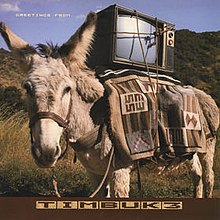Greetings from Timbuk3
| Greetings from Timbuk3 | ||||
|---|---|---|---|---|
 | ||||
| Studio album by | ||||
| Released | October 1986 | |||
| Recorded | Dustbowl Studios (Hollywood) *except "Hairstyles and Attitudes" at Lone Star Studios (Austin, Texas) | |||
| Genre | Rock | |||
| Length | 36:05 | |||
| Label | I.R.S.[1] | |||
| Producer | Dennis Herring[2] | |||
| Timbuk 3 chronology | ||||
| ||||
| Review scores | |
|---|---|
| Source | Rating |
| AllMusic | |
| Robert Christgau | A-[4] |
| The Encyclopedia of Popular Music | |
| MusicHound Rock: The Essential Album Guide | |
Greetings from Timbuk3 is the debut album by American band Timbuk 3, released in 1986.[6][7] The album contains their only charting single, "The Future's So Bright, I Gotta Wear Shades," which reached number 19 on the US Billboard Hot 100.
The songs "Life is Hard" and "Shame on You" were used in the 1986 film The Texas Chainsaw Massacre 2 and were included on the film's accompanying soundtrack album.[citation needed]
Critical reception[]
Trouser Press called Greetings from Timbuk3 "surely one of the darkest albums ever to have yielded a hit single."[8]
Track listing[]
All songs written by Pat MacDonald, except where noted. Copyright Mamdadaddi Music/I.R.S. Music, Inc. admin. by Atlantic Music. (All Songs BMI).
- "The Future's So Bright, I Gotta Wear Shades" – 3:21
- "Life Is Hard" – 4:08
- "Hairstyles and Attitudes" – 2:51
- "Facts About Cats" – 3:16
- "I Need You" – 3:50
- "Just Another Movie" – 4:16
- "Friction" – 3:44
- "Cheap Black & White" – 2:54
- "Shame On You" – 5:04 (Barbara K. MacDonald, Pat MacDonald)
- "I Love You in the Strangest Way" – 2:41
Personnel[]
- Barbara K. MacDonald – co-lead vocals on tracks 1, 5, 10, lead vocals on tracks 4, 9, backing vocals, keyboards, synthesizers, electric, 12-string and acoustic guitars, bass, drums, percussion, harmonica, violin, mandolin
- Pat MacDonald – co-lead vocals on tracks 1, 5, 10, lead vocals on tracks 2, 3, 6, 7, 8, backing vocals, keyboards, synthesizers, electric, 12-string and acoustic guitars, bass, drums, percussion, harmonica, violin, mandolin
Production[]
- Produced by Dennis Herring
- Engineers: Dennis Herring and Mark Teston
Charts[]
| Chart | Peak position |
|---|---|
| Australia (Kent Music Report)[9] | 86 |
| UK Albums Chart[10] | 51 |
| US Billboard 200[11] | 50 |
References[]
- ^ Plasketes, George (April 22, 2016). Please Allow Me to Introduce Myself: Essays on Debut Albums. Routledge. ISBN 9781317079743 – via Google Books.
- ^ Jump up to: a b MusicHound Rock: The Essential Album Guide. Visible Ink Press. 1999. p. 1152.
- ^ AllMusic.com
- ^ "Robert Christgau: CG: Timbuk 3". www.robertchristgau.com.
- ^ Larkin, Colin (2006). The Encyclopedia of Popular Music. Volume 8: MUZE. p. 182.CS1 maint: location (link)
- ^ Sasfy, Joe (October 3, 1986). "Wry" – via www.washingtonpost.com.
- ^ "Timbuk 3 | Biography & History". AllMusic.
- ^ "Timbuk 3". Trouser Press. Retrieved 7 February 2021.
- ^ Kent, David (1993). Australian Chart Book 1970–1992 (illustrated ed.). St Ives, N.S.W.: Australian Chart Book. p. 310. ISBN 0-646-11917-6.
- ^ "TIMBUK 3 - full Official Chart History - Official Charts Company". www.officialcharts.com. Retrieved 31 July 2018.
- ^ "Timbuk 3 Chart History". Retrieved 31 July 2018.
Categories:
- 1986 debut albums
- Timbuk 3 albums
- I.R.S. Records albums
- Albums produced by Dennis Herring
- 1980s rock album stubs